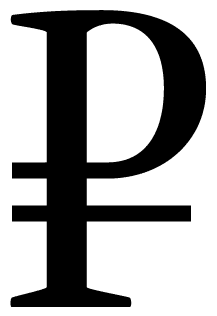Ruble sign
The Duma adopted the law on the ruble sign, and the Bank of Russia (BR) should develop it, but whatever happens "as always" the largest font and design studios of Russia chose the ruble sign themselves (based on the competition) and propose to start using it without waiting for the version BR, so that in such a way to force the Bank of Russia to choose this symbol, and not another crafts of a nephew of a bank director or the like.

Initiative group:
Paratype (The creators of the Cyrillic version of the font Arial, and the most famous font studio in Russia)
Letterhead
Art. Lebedev Studio
Design Depot
Designer
Direct design
Image design
To select the “Ruble Sign” symbol, we used objective criteria important for its effective use:
')
1. Easy graphics,
2. Difference from other characters of the letter accepted in the main font systems, first of all in Cyrillic and Latin,
3. Intuitive clarity to the representative of the Russian culture. The sign is introduced primarily into the internal circulation, so it is more important that the Russians take it correctly than foreigners,
4. Convenience of writing by hand (among other things, motor memorization is the fastest and most reliable),
5. One-piece. A single grapheme character is faster to read and, as a rule, takes up less space. A one-piece, non-gigantic sign is easier to integrate into a table set, which is extremely important in this case.
6. Fontindependence. A symbol, a grapheme, and not a sign of a specific font is introduced into use. This grapheme must be stylized to fit any typeface of an existing or future font with the addition of the ruble sign,
7. Uniform density. The absence of overloaded with strokes zones, too small, optional strokes. These parameters become decisive in small-point selection. The sign should not swim in the fourth size of the text font,
8. Width is no more than zero (the widest digit). An important parameter: in typed fonts, the width of currency symbols should correspond to the width of digits to simplify the table set,
9. Understanding a foreigner who is familiar with Latin
10. The presence of mild unusualness within the normal range, which promotes memorization and recognition.
A source

Initiative group:
Paratype (The creators of the Cyrillic version of the font Arial, and the most famous font studio in Russia)
Letterhead
Art. Lebedev Studio
Design Depot
Designer
Direct design
Image design
To select the “Ruble Sign” symbol, we used objective criteria important for its effective use:
')
1. Easy graphics,
2. Difference from other characters of the letter accepted in the main font systems, first of all in Cyrillic and Latin,
3. Intuitive clarity to the representative of the Russian culture. The sign is introduced primarily into the internal circulation, so it is more important that the Russians take it correctly than foreigners,
4. Convenience of writing by hand (among other things, motor memorization is the fastest and most reliable),
5. One-piece. A single grapheme character is faster to read and, as a rule, takes up less space. A one-piece, non-gigantic sign is easier to integrate into a table set, which is extremely important in this case.
6. Fontindependence. A symbol, a grapheme, and not a sign of a specific font is introduced into use. This grapheme must be stylized to fit any typeface of an existing or future font with the addition of the ruble sign,
7. Uniform density. The absence of overloaded with strokes zones, too small, optional strokes. These parameters become decisive in small-point selection. The sign should not swim in the fourth size of the text font,
8. Width is no more than zero (the widest digit). An important parameter: in typed fonts, the width of currency symbols should correspond to the width of digits to simplify the table set,
9. Understanding a foreigner who is familiar with Latin
10. The presence of mild unusualness within the normal range, which promotes memorization and recognition.
A source
Source: https://habr.com/ru/post/12792/
All Articles